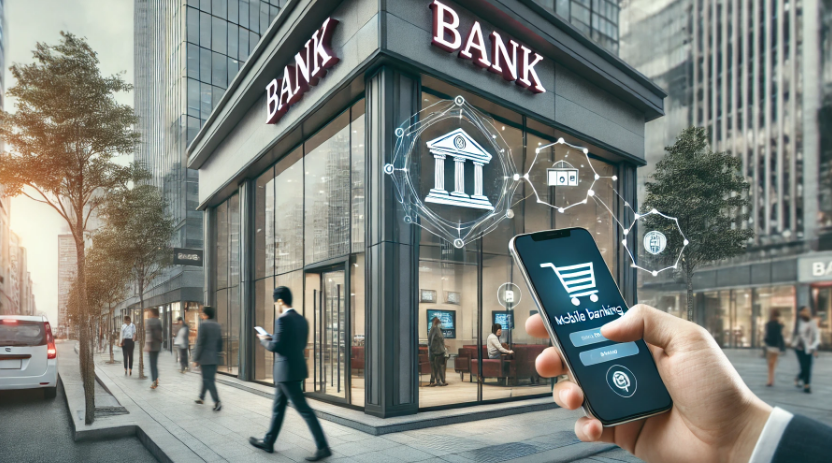In recent years, the banking landscape in the United States has witnessed a profound transformation. Mobile banking apps have surged in popularity, offering unprecedented convenience and accessibility to customers.
Gone are the days when a trip to the bank was necessary for everyday transactions or inquiries. Now, with just a few taps on a smartphone, users can manage their finances from anywhere, at any time. As the use of these mobile apps continues to grow, an important question arises: are traditional, brick-and-mortar banks on the verge of obsolescence?
While some argue that the personal touch of in-person banking still holds significant value, others believe that the rapid development of mobile banking apps is redefining the financial services industry. This article explores the rise of mobile banking in the U.S. and delves into whether physical banks can still compete in an increasingly digital world.
The rise of mobile banking apps: convenience at your fingertips

The shift towards mobile banking in the U.S. has been nothing short of remarkable. Over the past decade, consumers have gravitated towards the convenience of managing their finances through mobile apps. According to a report by Insider Intelligence, over 80% of U.S. adults have used mobile banking services as of 2023, and that number is expected to grow even further.
One of the key factors driving this trend is the sheer convenience that mobile banking offers. Consumers no longer need to visit a physical bank branch to check their account balance, transfer funds, or pay bills. Everything can be done through an app, often with user-friendly interfaces that streamline these processes.
Additionally, the integration of features like mobile check deposits, digital wallets, and even loan applications have made these apps indispensable for many users. For younger generations, especially millennials and Gen Z, mobile banking is often the preferred method of managing finances.
These tech-savvy customers have grown up with digital devices and expect seamless experiences across all aspects of life, including banking. As a result, many traditional banks have been forced to invest heavily in developing their own mobile apps to stay relevant in an increasingly digital world.
The convenience factor, coupled with the increasing capabilities of mobile apps, is driving this shift in consumer behavior and changing the way Americans bank.
Are physical bank branches still necessary?
With the rapid growth of mobile banking apps, many are questioning the necessity of traditional brick-and-mortar bank branches. For generations, these physical locations have served as the backbone of the banking industry, offering face-to-face customer service and handling complex transactions.
However, as mobile banking becomes more sophisticated, the need for physical branches has been called into question. While it’s true that many routine banking tasks can now be completed entirely through an app, there are still certain services that physical branches excel at.
For example, some customers prefer in-person consultations when applying for mortgages, business loans, or other significant financial decisions. The personal interaction with a bank representative can provide a level of trust and reassurance that is difficult to replicate through a mobile app.
Moreover, older generations or those less comfortable with technology may still rely on in-person banking for their needs. Physical branches often serve as a safety net for individuals who are unfamiliar with, or distrustful of, digital banking solutions. In addition, rural areas or locations with limited internet access may still depend on physical banks for essential services.
That said, the number of physical bank branches has been declining in recent years. According to the Federal Deposit Insurance Corporation (FDIC), the U.S. has seen a steady reduction in the number of brick-and-mortar branches, as banks focus more on enhancing their digital offerings. This trend suggests that while physical banks are not yet obsolete, they are certainly being re-evaluated in a rapidly changing financial landscape.
The future of banking: digital-first or hybrid approach?
As mobile banking apps continue to evolve, the future of the banking industry seems to be heading toward a more digital-first approach. Many financial institutions are investing heavily in their mobile platforms, recognizing that customers want fast, accessible, and secure ways to manage their money.
With advancements in technology like artificial intelligence (AI) and blockchain, mobile banking apps are only going to become more sophisticated, offering personalized services that cater to individual user needs. However, a fully digital banking ecosystem may not be the ultimate outcome. A hybrid approach, where physical branches coexist with mobile platforms, seems more likely.
Even as mobile banking gains traction, there are certain scenarios where a physical bank presence remains important. For instance, banks may opt to maintain smaller, more specialized branches that focus on complex financial services or serve communities with limited access to digital tools.
Furthermore, the trust factor plays a significant role in banking. While mobile apps offer convenience, security concerns still exist for some consumers. Cybersecurity threats, data breaches, and hacking incidents can undermine trust in fully digital systems. A hybrid approach that combines the ease of mobile banking with the reassurance of physical branches may offer the best of both worlds.
Ultimately, the future of banking will likely depend on how well financial institutions can balance the growing demand for mobile solutions with the need for personalized, in-person services. As more customers embrace mobile banking, banks will need to continue innovating, but not at the expense of those who still prefer or require traditional services.
The rise of mobile banking apps in the United States has undeniably changed the way consumers manage their finances. While these apps offer unparalleled convenience and are rapidly gaining popularity, the question of whether physical bank branches are becoming obsolete is more complex than it might initially seem. Traditional banks still play an important role, particularly for those who value face-to-face interactions or require more specialized services.
That being said, the future of banking is likely to be a hybrid model, where mobile and physical banking coexist. As technology continues to advance, the lines between digital and in-person services will continue to blur. The key for banks will be to strike a balance that meets the diverse needs of their customers, ensuring that no one is left behind in the shift toward a more digital financial world.





